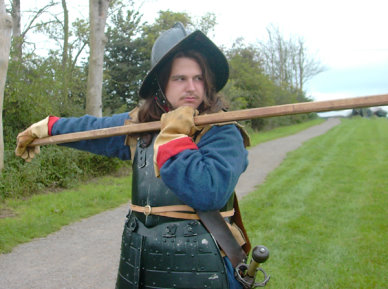|
What can I do? Members can choose several different roles to play in Battles, Living history displays and social events. |
||||
|
PIKEMEN Carrying steel tipped pikes that were 18 ft long, pikemen acted as the defensive arm of the regiment. Additionally, they were armed with a short sword called a tuck. They protected the musketeers from cavalry attack and dominated hand to hand combat once musket ammunition ran low. In re-enactments this is a physically demanding but exhilarating role. Pikemen must wear a morion helmet and leather gloves, and may wear body armour (Back and Breastplate). |
 |
|||
|
MUSKETEERS Provded the main firepower of the regiment using matchlock muskets that fired in close order volleys. Becoming a musketeer involves some financial commitment in buying and obtaining both a shotgun certificate and a black powder certificate. Before firing on the battlefield, all Sealed Knot musketeers must also be examined and passed by the Society's Safety Inspectorate |
 |
|||
|
||||
|
ENSIGN. Carrying the colour in battle was an honour originally given to a senior soldier
( The ’ancient’) By the Civil War the Colour was carryied by a
Junior Officer equivalent to Second Lieutenant in the modern army. An Infantry
colour was about 6 ft square, but Cavalry and Dragon units carried a smaller
flag known as a guidon. Each Company of foot or troop of horse carried its own colour or guidon |
 |
|||
|
MUSICIANS. Playing drums and wind instruments, Musicians formed an integral part of the regiment. In battle, drummers were used to give an audible signal of orders as shouted commands couldn't always be heard. Drummers and Trumpeters were also commonly used to carry messages between the opposing commanders, issuing terms of surrender or offering the exchange of prisoners. |
 |
|||
|
THE BAGGAGE TRAIN: Camp followers comprised of the wives and children of soldiers as well as the looser type of woman always closely associated with armies. They helped the regiment by cooking, washing and basic nursing care. In addition, there is a role for any of the professionals and tradesmen whose skills were required by the army. This might include surgeons, blacksmith, artillery engineers and clergymen. A number of different tasks can be given during battle reenactments and an even greater variety of roles are possible for living history events. |
 |
|||
|
TRADERS AND SUPPLIERS for most items of equipment can now be found within the society, however we will be pleased to advise members wishing to make all or part of their costume themselves. We also continually need craftsmen and traders in reproduction equipment and clothing of a high standard |
||||
|
Sir Henry Vaughans Company Home Page Taking part in Sealed Knot reenactments and living history Displays right across the country |
 |
